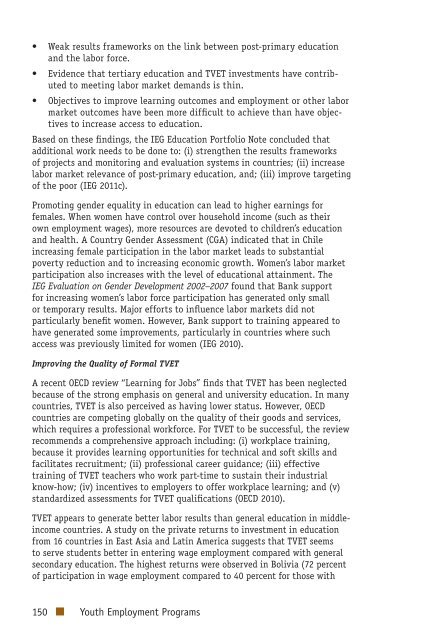Youth Employment Programs - Independent Evaluation Group
Youth Employment Programs - Independent Evaluation Group
Youth Employment Programs - Independent Evaluation Group
You also want an ePaper? Increase the reach of your titles
YUMPU automatically turns print PDFs into web optimized ePapers that Google loves.
• Weak results frameworks on the link between post-primary educationand the labor force.• Evidence that tertiary education and TVET investments have contributedto meeting labor market demands is thin.• Objectives to improve learning outcomes and employment or other labormarket outcomes have been more difficult to achieve than have objectivesto increase access to education.Based on these findings, the IEG Education Portfolio Note concluded thatadditional work needs to be done to: (i) strengthen the results frameworksof projects and monitoring and evaluation systems in countries; (ii) increaselabor market relevance of post-primary education, and; (iii) improve targetingof the poor (IEG 2011c).Promoting gender equality in education can lead to higher earnings forfemales. When women have control over household income (such as theirown employment wages), more resources are devoted to children’s educationand health. A Country Gender Assessment (CGA) indicated that in Chileincreasing female participation in the labor market leads to substantialpoverty reduction and to increasing economic growth. Women’s labor marketparticipation also increases with the level of educational attainment. TheIEG <strong>Evaluation</strong> on Gender Development 2002–2007 found that Bank supportfor increasing women’s labor force participation has generated only smallor temporary results. Major efforts to influence labor markets did notparticularly benefit women. However, Bank support to training appeared tohave generated some improvements, particularly in countries where suchaccess was previously limited for women (IEG 2010).Improving the Quality of Formal TVETA recent OECD review “Learning for Jobs” finds that TVET has been neglectedbecause of the strong emphasis on general and university education. In manycountries, TVET is also perceived as having lower status. However, OECDcountries are competing globally on the quality of their goods and services,which requires a professional workforce. For TVET to be successful, the reviewrecommends a comprehensive approach including: (i) workplace training,because it provides learning opportunities for technical and soft skills andfacilitates recruitment; (ii) professional career guidance; (iii) effectivetraining of TVET teachers who work part-time to sustain their industrialknow-how; (iv) incentives to employers to offer workplace learning; and (v)standardized assessments for TVET qualifications (OECD 2010).TVET appears to generate better labor results than general education in middleincomecountries. A study on the private returns to investment in educationfrom 16 countries in East Asia and Latin America suggests that TVET seemsto serve students better in entering wage employment compared with generalsecondary education. The highest returns were observed in Bolivia (72 percentof participation in wage employment compared to 40 percent for those with150 <strong>Youth</strong> <strong>Employment</strong> <strong>Programs</strong>
















